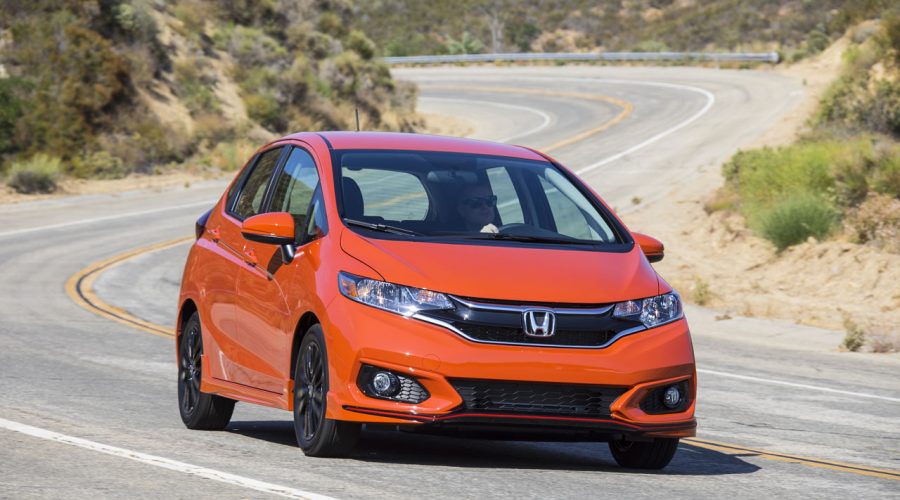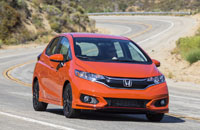
The ultra-practical Honda Fit subcompact hatchback gets a thorough mid-cycle refresh for 2018, with edgier styling, a new Sport trim line, and the availability of Honda Sensing advanced driver-assistance systems.
In a press release, Honda claims this 2018 update adds “youthful, sporty and emotional character” to a model already moving into the fourth year of its third generation, the new 2018 Fit’s styling enhancements including “a horizontally layered, two-piece chrome and piano black grille with a larger, more prominent “H” mark,” plus “more integrated and sophisticated” headlamp clusters that “blend into the side edges of the upper fascia’s wing creating a unified yet more aggressive design.” Additionally, Honda has added new chrome accents to the front bumper plus a full-width splitter below, as well as “more angular fog lights pods” to the frontal design.
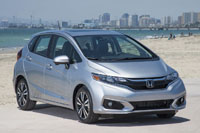
The 2018 Fit gets updated combination taillights in the rear and a reworked back bumper too, the latter feature now incorporating a “full-width character line in piano black” plus a “splitter-shaped” lower apron. Lastly, new Orange Fury paint is kept exclusively for an entirely new Sport trim level.
The 2018 Honda Fit is available in the same DX, LX, EX and EX-L Navi trims as last year’s version, now priced at $15,190, $18,590, 21,890 and $23,990 respectively, but new this year is a $19,590 Sport trim that slots in between LX and EX models.
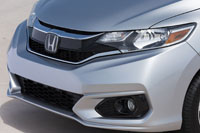
A standard aero kit adds muscle to the new Fit Sport’s front, side and rear body panels for a more aggressive look, with bright orange pin-striping highlighting the deeper front splitter and tri-strake rear diffuser, no matter the exterior colour chosen. Additionally, gloss-black painted 16-inch alloys fill out each corner while a chromed exhaust finisher and “SPORT” liftgate badge complete the Fit Sport’s exterior design enhancements. Finally, the Fit Sport boasts an all-black cabin with unique orange contrast stitching.
New 2018 Fit Sport trim may get the exclusive option of Orange Fury paint, but the rest of its colour palette is limited to Crystal Black Pearl and White Orchid Pearl, with Modern Steel Metallic (medium grey), available with the base DX and other trims, taken off the menu. Likewise, Milano Red, available on LX trims and above, plus Aegean Blue Metallic, optional on the EX and EX-L Navi, are unavailable with the Sport.
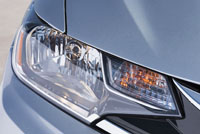
“With sporty new styling and additional feature content, the 2018 Honda Fit ups the ante with new styling and sophistication not typically found in the subcompact segment,” said Jean Marc Leclerc, Senior Vice-President Sales and Marketing, Honda Canada Inc. “Fit has always represented a great value for subcompact customers and the addition of available Honda Sensing to its fun-to-drive performance and unmatched versatility will keep the Honda Fit as the industry’s benchmark subcompact.”
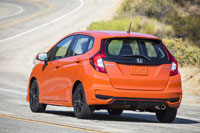
Benchmarks in mind, archrival Toyota was first to offer advanced driver-assistance systems to the subcompact category with its 2017 Yaris hatchback, its Safety Sense C suite of driver-assistance systems adding automatic high beams, a pre-collision system with autonomous emergency braking capability, and lane departure alert to its $15,475 base trim level, but the 2018 Fit’s available Honda Sensing system is a more technologically advanced package thanks to autonomous emergency braking joining lane/road departure warning with mitigating assist, as well as adaptive cruise control, although it doesn’t include auto high beams.
Nevertheless, Honda is confident enough to rightly claim the new 2018 Fit with Honda Sensing offers, “the most robust suite of available advanced safety and driver-assistive technologies in its class in Canada.” Choosing Honda Sensing adds $1,300 to the Fit LX and Sport trims, while it comes standard with the Fit EX and EX-L Navi.
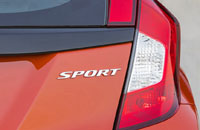
The 2018 Fit’s direct-injection 16-valve, DOHC, i-VTEC-enhanced 1.5-litre four-cylinder engine is carryover albeit slightly downgraded from 130 to 128 horsepower and 114 to 113 lb-ft of torque, although the car’s claimed curb weight has now been reduced from 1,177 to 1,133 kilos (2,595 to 2,498 lbs) in base form, which should allow for similar if not better performance. Of note, Sport trim with the CVT, plus EX and EX-L Navi models receive standard steering wheel-mounted paddle shifters to improve performance and driver engagement.
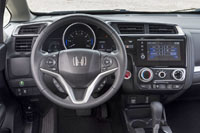
Honda claims an impressive five-cycle fuel economy rating of 8.1 L/100km in the city, 6.6 on the highway and 7.4 combined with the base six-speed manual, 7.0 L/100km city, 5.9 highway and 6.5 combined with the CVT in LX trim, or alternatively 7.6 L/100km city, 6.5 highway and 7.0 combined in EX trim and above, which only come with the CVT. This represents a marginal improvement when compared to last year’s claimed fuel economy.
The Fit has always delivered excellent driving dynamics for its class, but nevertheless Honda has added retuned suspension dampers to the 2018 model, while also making its electric power-assisted rack-and-pinion steering system more rigid, and providing a stiffer structure overall thanks to more body reinforcements. This helps to improve crash resistance, ride quality and handling prowess, as well as interior refinement, the new Fit said to be quieter than the outgoing model. Along with the stiffer structure, Honda achieved the 2018 Fit’s refinement goals by revising its transmission and steering system mounting hardware, while acoustic-laminated glass and more insulation has been added throughout.
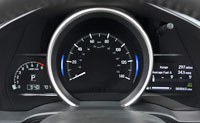
Standard features for the base 2018 Fit DX include auto-off multi-reflector halogen headlights, heatable powered side mirrors, LED brake lights, power locks with remote access, power windows, intermittent windshield wipers, an intermittent rear wiper/washer, tilt and telescopic steering, a 5.0-inch colour LCD infotainment display, a multi-angle rearview camera, Bluetooth mobile phone connectivity with streaming audio, four-speaker 160-watt AM/FM/MP3/WMA audio, a USB port, a 12-volt power outlet, the Fit’s unique 60/40-split second-row Magic Seat, 60/40 split-folding rear seatbacks, cargo area tie-down hooks, 15-inch steel wheels with covers on 185/6 all-season tires, front disc and rear drum brakes with ABS, electronic brake-force distribution and brake assist, traction and stability control, hill start assist, and the usual assortment of advanced airbags.
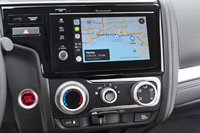
Additionally, the LX adds a rear rooftop spoiler, illuminated steering wheel-mounted switchgear including cruise control, filtered air conditioning, a new 7.0-inch infotainment touchscreen with Apple CarPlay and Android Auto, Siri Eyes Free, text message functionality, Wi-Fi tethering, a second USB port, the HondaLink Assist automatic emergency response system, a front centre console with an armrest and storage bin, heatable front seats, another 12-volt power outlet, a cargo cover, and more.
On top of everything already mentioned, new Sport trim adds auto-on/off headlights, fog lights, a leather-wrapped steering wheel and shift knob, two more stereo speakers and 20 additional watts of power to the audio system, plus more.
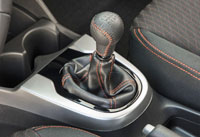
EX trim builds on these features with proximity-sensing keyless access with pushbutton ignition, Honda’s impressive LaneWatch blindspot display that projects a rearward view of the passenger’s side lane, a powered moonroof, extendable sunvisors, etcetera.
Lastly, top-line EX-L Navi trim includes LED turn signals integrated into the side mirror housings, automatic climate control, navigation with detailed mapping and voice recognition, satellite and HD radio, leather upholstery, and more.
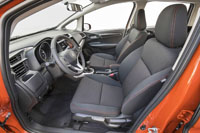
All of this equipment comes in a subcompact hatchback renowned for offering the most accommodating interior in its class. In fact, with its rear seats laid flat a total of 1,492 litres (52.7 cubic feet) is available. Even better, when the backrests of the Fit’s rear Magic Seats are upright it’s possible to flip their lower cushions upwards for yet more cargo capacity, especially helpful for loading in taller items like bicycles or plants, this combining for a collective 609 litres (21.5 cubic feet) of available cargo space when including the Fit’s dedicated luggage area in back. What’s more, the front passenger’s seat can be folded forward to allow ultra-long cargo inside, while both front seats can be laid completely flat when their headrests are removed, providing a large safe place for impromptu camping. No competitor comes close to the Fit when it comes to passenger and cargo flexibility.
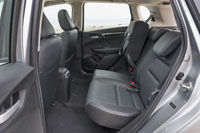
Still, the question remains whether all of the Fit’s ongoing attributes, together with the 2018 improvements, will boost its sagging sales numbers, or more precisely whether Honda will be able to keep up to customer demand. To be clear, the roller coaster ride Honda’s smallest car has endured since being available in North America is unusual to say the least. For some background, the first-generation Honda Fit came in with a bang after arriving on Canadian soil in April of 2006 with 10,634 sales, which quickly escalated to 13,507 deliveries in 2007 and then an all-time high of 14,836 down the road in 2008, but since then it’s experienced sales chart mayhem.
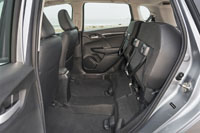
With more in common with the highly volatile Bitcoin cryptocurrency than anything automotive, Fit sales ebbed to 9,553 units in 2009 despite seeing an all-new second-generation model arrive partway through the year, after which it dropped to 7,900 deliveries the following year, and then plummeted to just 2,835 in 2011. Calendar year 2012 saw improvement to 4,736 units before a strong 2013 with 9,512 buyers, whereas the advent of the current third-generation Fit in 2014 provided 11,732 deliveries for its best sales results so far this decade.
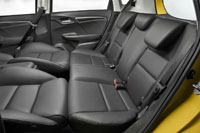
Since then it’s been on another downward spiral claimed to be due to production issues caused by the immensely popular HR-V subcompact SUV that’s built at the same plant in Celaya, Guanajuato, Mexico, the result being 9,088 Fit deliveries in 2015, 8,622 in 2016, and after six months of 2017 a meager 2,191 units leaving Canadian dealerships. To ease pressure on its Mexican facility and support the car’s many North American advocates Honda started importing additional Fit models from its production facility in Japan, but evidently not enough.
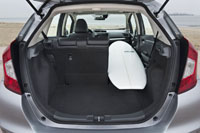
To appreciate how much ground the Fit has lost since last year came to an end, its 8,622 unit total made it second most popular in the subcompact class when compared to the Accent’s 19,198 sales, but by the close of Q2 2017 it stood sixth out of 11 competitors, with two of the segment’s five slowest sellers including a dedicated hybrid and a full electric model. These would be the Toyota Prius C and new Chevrolet Bolt, with the competitors having past it for second, third, fourth and fifth place in the sales race being the Nissan Versa Note with 4,436 deliveries, the new Yaris Family (including the Yaris hatchback and Mazda-sourced Yaris iA sedan) with 3,053, the Mini Cooper with 2,762, and the Chevrolet Sonic with 2,712. Only the Kia Rio and Ford Fiesta, which also experienced dramatic declines in popularity this year, did worse with 2,122 and 1,052 sales respectively, other than also-ran Fiat 500L that only managed a paltry 32 sales during the same six months.
Along with the usual production issues, some of the Fit’s most recent difficulties can likely be blamed on a purposeful slowdown of production ahead of this 2018 model’s launch so that dealers don’t end up with excess stock, but not all. Either way, if you’re hoping to get your hands on a new 2018 Fit it’s probably a good idea to do so sooner than later.

